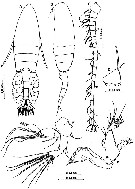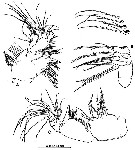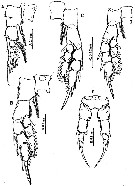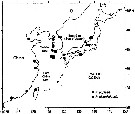|
|
 |
|
Calanoida ( Order ) |
|
|
|
Diaptomoidea ( Superfamily ) |
|
|
|
Pseudodiaptomidae ( Family ) |
|
|
|
Pseudodiaptomus ( Genus ) |
|
|
| |
Pseudodiaptomus poplesia (Shen, 1955) (F,M) | |
| | | | | | | Syn.: | Schmackeria poplesia Shen,1955; Chen & Zhang, 1965 (p.81, figs.F,M) | | | | Ref.: | | | Ohtsuka & al., 1995 (p.159); Walter, 1986 (p.132); 1986 a (p.503); 1987 (p.367); Soh & al., 2001 (p.204, figs.F,M); Eyun & al., 2007 (p.265, molecular biology) |  issued from : H.Y. Soh, H.-L Suh, O.H. Yu & S. Ohtsuka in Hydrobiologia, 2001, 448. [p.207, Fig.2]. Female (from Korean waters): A, habitus (dorsal); B, idem (lateral left side); C, left A1; D, 1st segment of left A1; E, A2; F, Md.
|
 issued from : H.Y. Soh, H.-L Suh, O.H. Yu & S. Ohtsuka in Hydrobiologia, 2001, 448. [p.209, Fig.4]. Female: A, Mx1; B, Mx2; C, Mxp.
|
 issued from : H.Y. Soh, H.-L Suh, O.H. Yu & S. Ohtsuka in Hydrobiologia, 2001, 448. [p.210, Fig.5]. Female: A, P1; B, P2; C, P3; D, P4; E, P5 (anterior view; arrow indicates a posterior seta).
|
 issued from : H.Y. Soh, H.-L Suh, O.H. Yu & S. Ohtsuka in Hydrobiologia, 2001, 448. [p.208, Fig.3 A, B]. Female: A-B, Scanning electron micrographs of the genital area (ventral view).
|
 issued from : H.Y. Soh, H.-L Suh, O.H. Yu & S. Ohtsuka in Hydrobiologia, 2001, 448. [p.211, Fig.6]. Male: A, habitus (dorsal); B, idem (lateral left sife); C, right A1 (arrowheads indicate aesthetascs); D, P5 (posterior view).
| | | | | Compl. Ref.: | | | Ohtsuka & al., 2008 (p.115, Table 6); Sakaguchi & al., 2011 (p.18, Table 2, occurrences); Zhang H. & al., 2013 (p.57, Rem. p.58); Park E-O. & al., 2013 (p.1, annual variation, sex ratio) | | | | NZ: | 1 | | |
|
Distribution map of Pseudodiaptomus poplesia by geographical zones
|
| | | | | |  issued from : H.Y. Soh, H.-L Suh, O.H. Yu & S. Ohtsuka in Hydrobiologia, 2001, 448. [p.214, Fig.9]. issued from : H.Y. Soh, H.-L Suh, O.H. Yu & S. Ohtsuka in Hydrobiologia, 2001, 448. [p.214, Fig.9].
Zoogeography of P. poplesia and P. nihonkaiensis in eastern Asia. |
 Issued from : E-O. Park, J.R. Cordell & H.Y. Soh in Zool. Stud., 2013, 52 (7). [p.6, Fig.6]. Issued from : E-O. Park, J.R. Cordell & H.Y. Soh in Zool. Stud., 2013, 52 (7). [p.6, Fig.6].
Seasonal variations in the adult sex composition of P. poplesia from Mankyung River estuary (South Korea).
(A): Oligohaline, (B): mesohaline, (C): polyhaline. Circle : female; triangle: male.
Nota: Males were more abundant than females across the entire salinity range throughout the study period (January to December 2000), except under oligohaline conditions in April, and the ratio of males to females reached 50% under mesohaline and polyhaline conditions in spring Gravid females were present in March to October0 comprising 3% to 72% of the female population. Under oligohaline conditions, <50% of the female population was gravid in July and also under mesohaline and polyhaline conditions in April and May. Percentages of gravid females were very low during fall months, and they did not occur under oligihaline conditions.
These facts indicate that abundance of P. poplesia as P. inopinus may be controlled by Chl a concentrations and salinity conditions. |
| | | | Loc: | | | China Seas (Bohai Sea, Yellow Sea, East China Sea, South China Sea, Jiaozhou Bay), Korea (Mankyung River estuary) | | | | N: | 7 | | | | Lg.: | | | (290) F: 2-2,2; M: 1,5-1,7; (922) F: 2,1-2,3; M: 1,6-1,8; {F: 2-2,3; M: 1,5-1,8} | | | | Rem.: | brackish.
Incomplete data.
In Lobus species group (forbesi subgroup) after Walter & al. 2006, p.203. | | | Last update : 23/01/2015 | |
|
|
 Any use of this site for a publication will be mentioned with the following reference : Any use of this site for a publication will be mentioned with the following reference :
Razouls C., Desreumaux N., Kouwenberg J. and de Bovée F., 2005-2025. - Biodiversity of Marine Planktonic Copepods (morphology, geographical distribution and biological data). Sorbonne University, CNRS. Available at http://copepodes.obs-banyuls.fr/en [Accessed October 18, 2025] © copyright 2005-2025 Sorbonne University, CNRS
|
|
 |
 |










